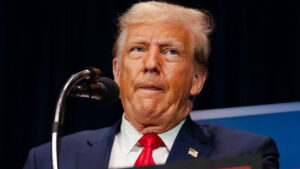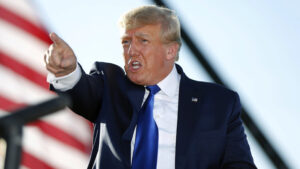Trump in Trouble As New Poll Reveals Major Update on His Chances of Winning The Election
Former President Donald Trump’s chances of winning the 2024 election have suddenly decreased, according to a recent polling model, as reported by Newsweek on Wednesday, June 19, 2024.
As the presumptive Republican presidential nominee, Trump is set to face his Democratic rival, incumbent President Joe Biden, in November. Despite a tight race reflected in numerous polls, a notable shift has been observed in the latest predictions.
Initially, daily prediction models indicated a strong likelihood of a Trump victory. On Tuesday, The Economist’s prediction model gave Trump a three in four chance of winning the election, forecasting a win with 306 Electoral College votes compared to Biden’s 232.
However, as of Wednesday, this outlook has changed significantly. The model now suggests that Trump’s chances have diminished to a two in three likelihood, with an estimated 300 Electoral College votes, while Biden’s chances have improved to one in three, with 238 votes.
The shift in Trump’s predicted fortunes underscores the volatility of the electoral landscape as Election Day approaches. The Electoral College, which allocates votes based on state populations, requires a candidate to secure at least 270 votes to win the presidency. This system means that winning the national popular vote does not necessarily guarantee electoral success.
The changing predictions from The Economist are mirrored by other polling data. An Echelon Insights poll conducted from June 10 to 12 among 1,013 voters showed Biden with a slight edge over Trump, garnering 48% of the vote to Trump’s 47%. This poll indicates a razor-thin margin that could swing either way as campaigning intensifies.
Further illustrating the fluctuating nature of the race, a projection by polling aggregator FiveThirtyEight on Sunday suggested an almost even split in the race’s outcome, with Trump winning 51 out of 100 election simulations and Biden winning 49. This near-parity highlights the unpredictability of voter sentiment and the potential for shifts in the coming months.
Christopher Phelps, a professor of modern American history at the University of Nottingham in the U.K., emphasized the importance of looking beyond the daily fluctuations in polling data. “The race will likely continue to narrow, as is typical, by November,” he told Newsweek.
“We can only hope that our news media begin to move away from the horse-race model of ‘who is ahead’ based on polls and models that have at best a mixed record of accuracy—and instead focus more on deeper analysis of the policy differences so that whatever choice the public makes is an informed one.”
As the election draws nearer, the candidates’ strategies and policy positions will come under increasing scrutiny. Trump and Biden are scheduled to meet for the first of two debates on June 27 in Atlanta.
These debates are expected to be pivotal moments in the campaign, offering each candidate a platform to directly address voters and differentiate their policy visions for the future of the country.
Despite the recent dip in his predicted chances, Trump remains a formidable contender. His campaign continues to capitalize on themes of economic revival, immigration reform, and national security, aiming to resonate with a broad base of supporters.
Meanwhile, Biden’s campaign emphasizes achievements during his presidency, such as infrastructure development, healthcare reforms, and climate change initiatives, aiming to appeal to a coalition of progressive and moderate voters.
The narrowing race also reflects broader dynamics in American politics, including demographic shifts, regional variations, and the impact of key issues such as the economy, social justice, and foreign policy.
As voters weigh these factors, the candidates’ ability to effectively communicate their visions and address voter concerns will be crucial.
Ultimately, while polling models and daily predictions provide a snapshot of the current electoral landscape, the outcome of the 2024 election remains uncertain.





